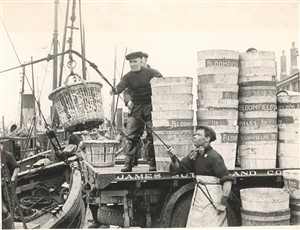The Fishing Industry in the 19th Century

Landing the Catch
Great Yarmouth Musuems
Photograph showing people landing the catch
By John Layton
The arrival of the Tower Curing Works
By the mid-19th century, when the Tower Curing Works began business, the industry was firmly in local control.
Where did they fish?
The best herring fishing grounds were some twenty miles out to sea in the shallower waters known as Smith's Knoll.
What types of vessel did they use?
This called for types of vessel that were sturdy, manoeuvrable and fast. Most were two or three-masted luggers, a type of sailing boat taking its name from the lug sail - that is, a large sail with a single long wooden spar at the top. There were no jibs or foresails, so the sail could be raised and dropped very quickly (for example, when landing on the beach). The relatively short mast and lack of a boom helped keep the decks clear for handling the nets.
The Time and Tide Museum displays contain paintings and models of these boats, which are quite different in appearance from contemporary trading vessels.
How large a crew did the vessels carry?
The crew consisted of about ten men.
What did the crew do when ashore?
Some were full-time fishermen, others were agricultural labourers known as joskins who joined the fishing fleet for the Autumn months once the land harvest was over.